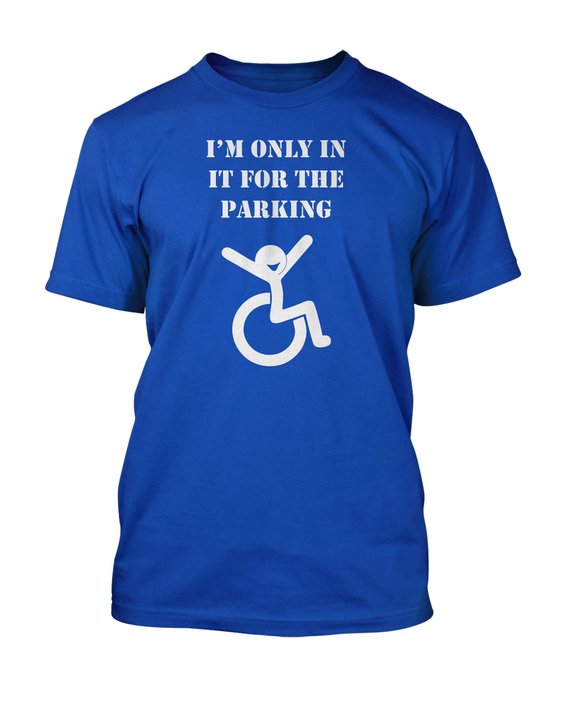When you first begin using a wheelchair, there’s an awful lot to get your head around. How a person responds to the chair will of course be different for each individual but as a very broad brush view, I guess most people will fit in to one of three groups and their reactions may be similar.
Firstly, there are people who become wheelchair users due to a progressive condition, such as Multiple Sclerosis or Motor Neurone Disease (‘Amyotrophic Lateral Sclerosis’ for people reading in the US & Canada). Or simply old age.
Secondly, there are people who acquire their wheelchair suddenly due to an injury.
Thirdly, people who were born with a physical disability.
As a very broad generalisation, those people who were born with the condition are likely to welcome their wheelchair. It gives them freedom and independence that they had not previously had. Because they’ve not known otherwise, the chair is often cherished and is a part of ‘them’. It is a liberator.
However, for the other two groups of people, becoming reliant upon a wheelchair for mobility can take some getting used to. More to the point, there may be some reluctance to using one. For many people with a progressive condition, becoming a wheelchair user may be quite distressing as they may have come to see it as reinforcing their physical deterioration. It may have been something that they battled against for quite some time.
When a person acquires a physical disability suddenly, such as a stroke, or as in my case, a spinal injury, the emotions can be very complex. Many people will experience anger & resentment at this sudden dependence upon these wheels. Other people may be more accepting, in that we can’t change what has happened, only get on with it.
Basically, while some people welcome the chair for the freedom it provides, other people may resent it as a visual indication to all around them, of their disability. Humans, being an awkward & unpredictable animal, will often ‘flip-flop’ between the extremes, different scenarios presenting differing emotions.
One of the key things in learning to love your chair, is gaining the confidence to go out in the first place. It is very clear that people with a physical disability are much more likely to become withdrawn from society. The reasons for this are many & varied. You can look at ‘The Social Model of Disability‘ and the barriers that society places in front of people, such as a lack of ramps dropped curbs, accessible parking or toilets. Sometimes the reason for not being an active member of society is because it is simply too much like hard work.
But the biggest obstacle to overcome isn’t the step outside the cafe that stops you getting in to it, you can always find another place that actually wants to take your money and encourage you to become their customer. No, it’s the barrier inside your own mind that you need to overcome.
And it is the barrier inside other people’s heads that you need to overcome too.
When I first began using a wheelchair, I repeatedly experienced the ‘invisibility‘ that comes with your first wheelchair, free of charge. It’s magical, you sit in the chair and suddenly people fail to see you! People talk over your head and pass your change to the person who is with you (because suddenly your friend has become your carer?)
The clearest example of this was when I was managing services for physically disabled people. We put on a display of Electronic Assistive Technology (EAT). This is kit that enables people with disabilities to communicate or interact with their environment. At the top end, you can control a computer using your eyes! It’s quite something when you switch lights on & off or dial a phone number just by looking at a computer! The display was open to anyone, so we had members of the public generally, people with disabilities & professionals. A conversation started with one such professional. I was sat in my chair, the professional stood to my left, the Deputy Manager (Michelle) to my right and someone else stood in front of me. The ‘professional’ was literally talking over my head, making no effort to involve me in the conversation. Although I knew more about EAT than my deputy, she was answering his questions without any problems so I didn’t need to interrupt. Eventually there was a pause in the conversation. I said “anyway, we’ve not been introduced, my name is Keith” and offered my hand for him to shake. With this, Michelle leant right over my head, and pointing down at me, said “yeah… he’s the boss”.
To his credit, the ‘professional’ blushed and apologised. Lesson learned hopefully!
When I first went out in public, I was incredibly self-conscious. I felt like people were looking at me more than they did when I was walking previously.
News Flash!
They were!
Because I was looking at other people more closely as I tried to judge which way they would step etcetera, they in turn noticed me looking at them and they look back. Try it yourself, next time you are walking through a crowd, look closely at the faces of people walking towards you and notice how quickly human beings pick up that they are being looked at and therefore look back at you more closely than normal? It is hundredths of a second for people to pick up that something is ‘odd’. Therefore, with hindsight, being looked at closely was in part because I was hyperaware of my surroundings & other people and therefore looking at them too much. As a new wheelchair user, you must just overcome this or you will avoid going where people are. Which is kind of everywhere.
When out and about, I found that people would often be uncomfortable interacting with me. I self-analysed this and believed that it was because many people found the chair to be a barrier in communication. They didn’t know how to acknowledge it, and therefore became uncomfortable, so avoided me.
That said, plenty of people who know me actively avoided me even before I became disabled, so…
But for the benefit of this blog, let’s assume it was the chair!
My way of dealing with this was to make my chair stand out more. I designed and purchased three sets of ‘spoke-guards’ [ https://www.spokeguards.co.uk] which are covers for the wheels.
I have a set for Morecambe Football Club (my wife once said “I think you love Morecambe football club more than you love me”. I replied “no dear, it’s just I loved Morecambe football club beforeI loved you”… yeah, I don’t know why she’s still with me either!)
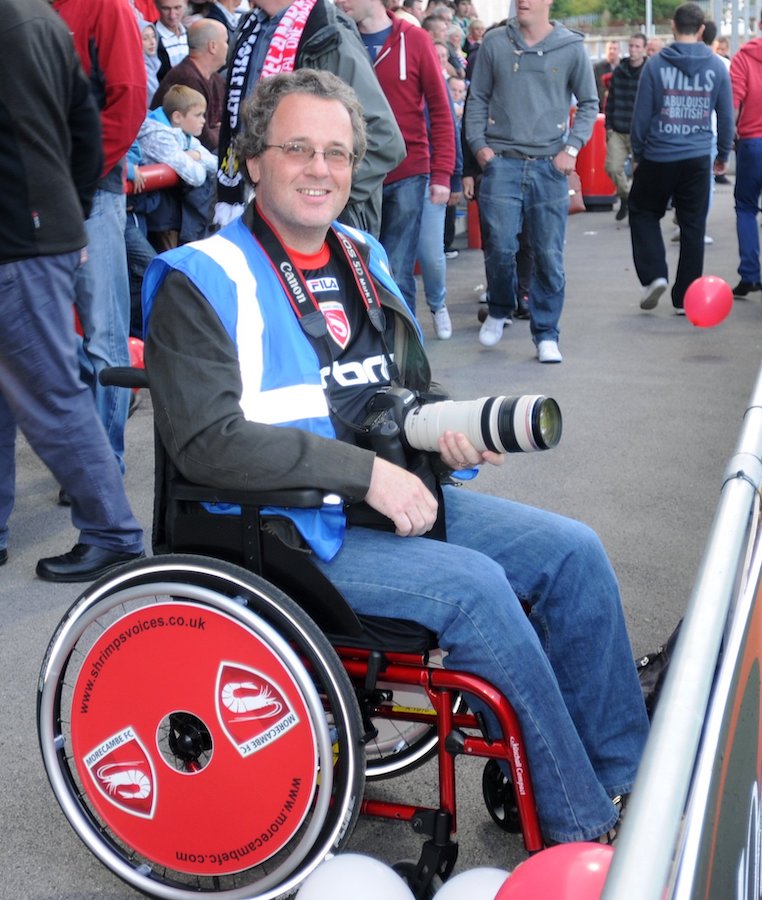
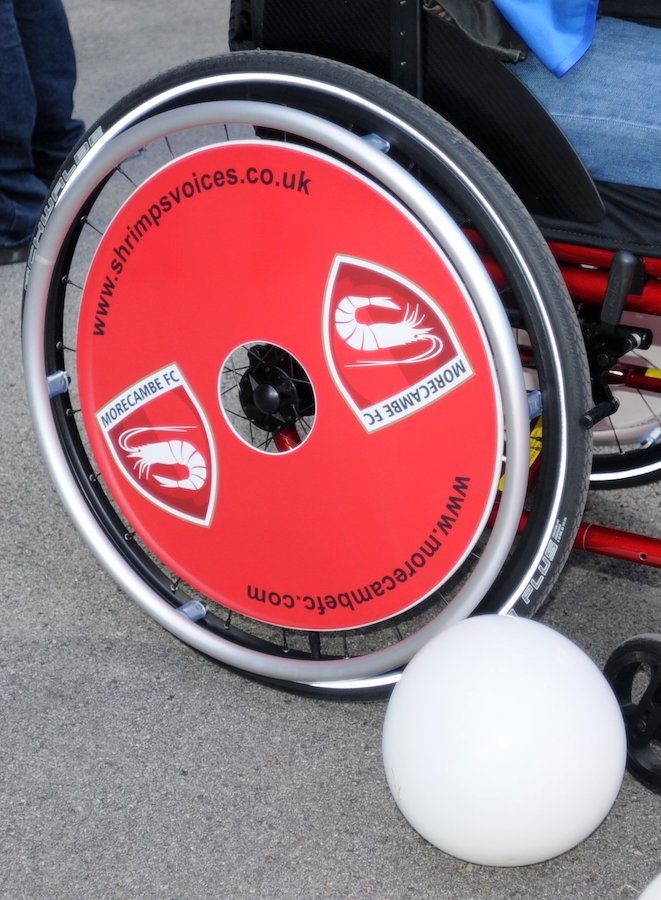

It was years ago… not that I’m bitter!
I’ve got a design for the Isle of Man 4×4 Club…
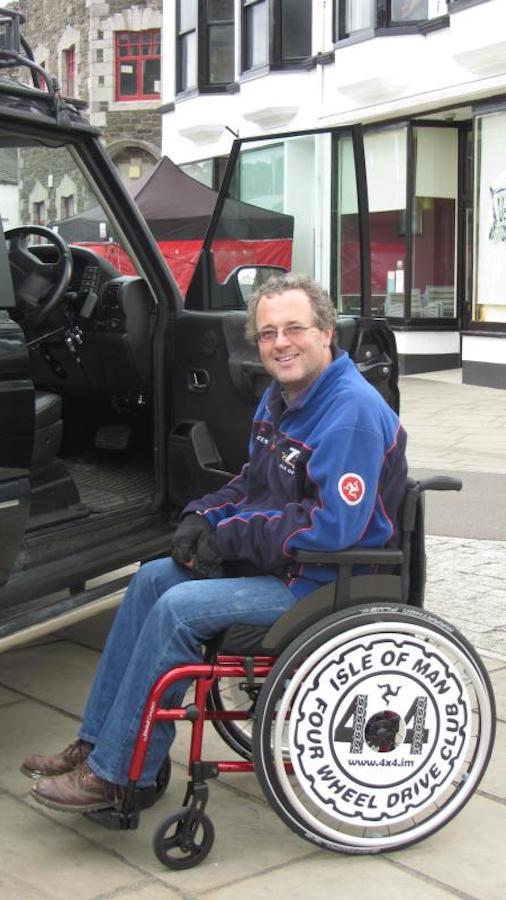
…and a ‘Three Legs of Mann‘ set. This pair are the ones most often on my chair. The Isle of Man motto is “Quocunque Jeceris Stabit“, which means “Whichever way you throw me, I will stand.” Somehow that’s appropriate!
And I like the irony of legs on a wheelchair!
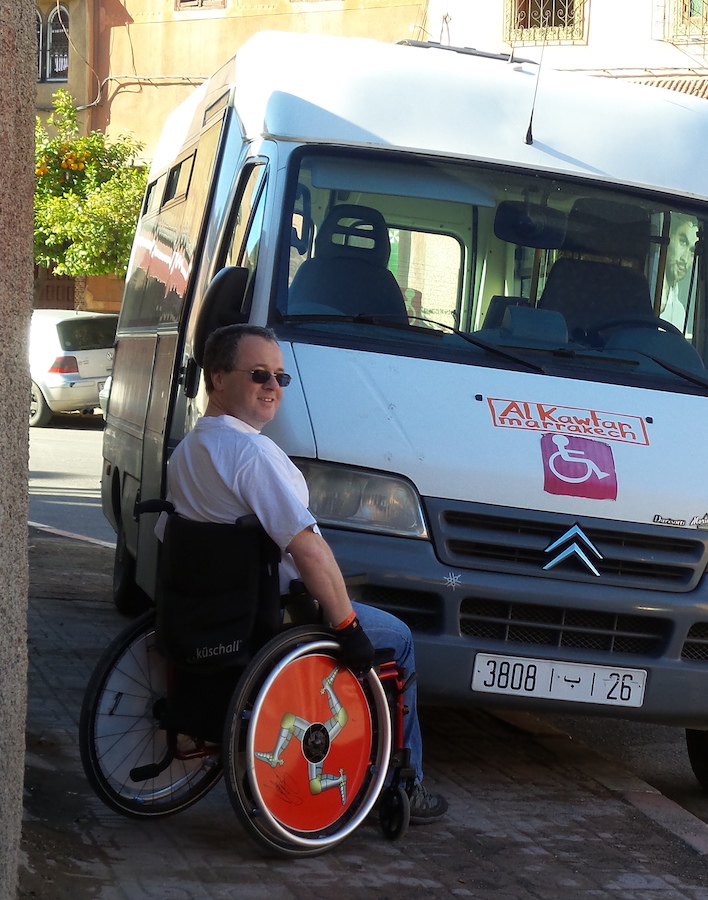
Wheelchair accessible vehicle blocking the pavement for wheelchair users & legs on a wheelchair. How much irony do you need?
This made such a difference. Random people in the street or shops would talk to me. “Cool wheels mate…” is something I’d hear regularly. Once the chair had been acknowledged, then that awkwardness was out of the way and they could interact with me. Rather than being a barrier to communication, the chair became an initiator of conversations. On one occasion I was at Manchester Airport, heading off to the Dominican Republic. A couple were walking towards me. As they passed, without breaking stride, the woman said “Moghrey mie”. That’s ‘good morning‘ in Manx. Obviously, they’d spotted the ‘cool wheels’.
Having blinged up my first wheelchair, I’ve since bought two other chairs. The ‘Mountain Trike‘ is something that immediately attracts anyone who has an interest in mechanics or mountain bikes. With top notch shock absorbers and driven by multiple chains, steered using a joystick type lever, it is certainly unusual and it is an attention magnet everywhere. Top TT racer John McGuinness & TV presenter Charley Boorman are two guys both obsessed with anything that has wheels.

I’ve met them both.
Both spent time using a wheelchair after bike accidents.
Both were intrigued by the trike.
Both wanted to have a go!
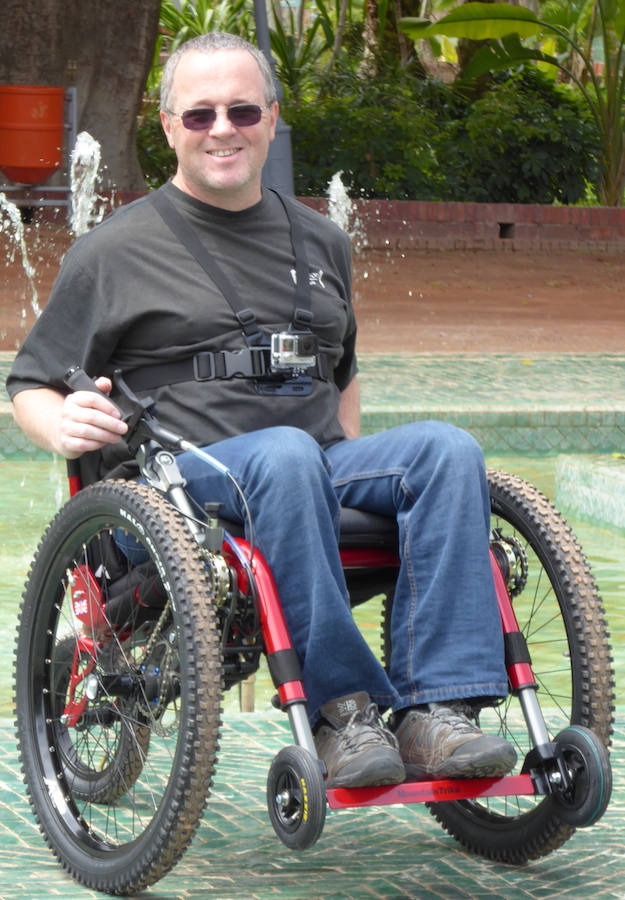
People having fun in someone else’s wheelchair should be encouraged more!
The third chair, it isn’t so much the wheelchair itself that is special, but the adaptation. The Batec is an electric powered ‘cycle’. It clips on to the front of a manual wheelchair, lifting the front casters up from the ground, turning the manual chair in to a powered cycle. This also attracts attention everywhere I go, both home and abroad and people often want a go! I’ll see them looking and pondering whether it is okay to ask! I’ll generally offer people a go and many take me up on the offer.
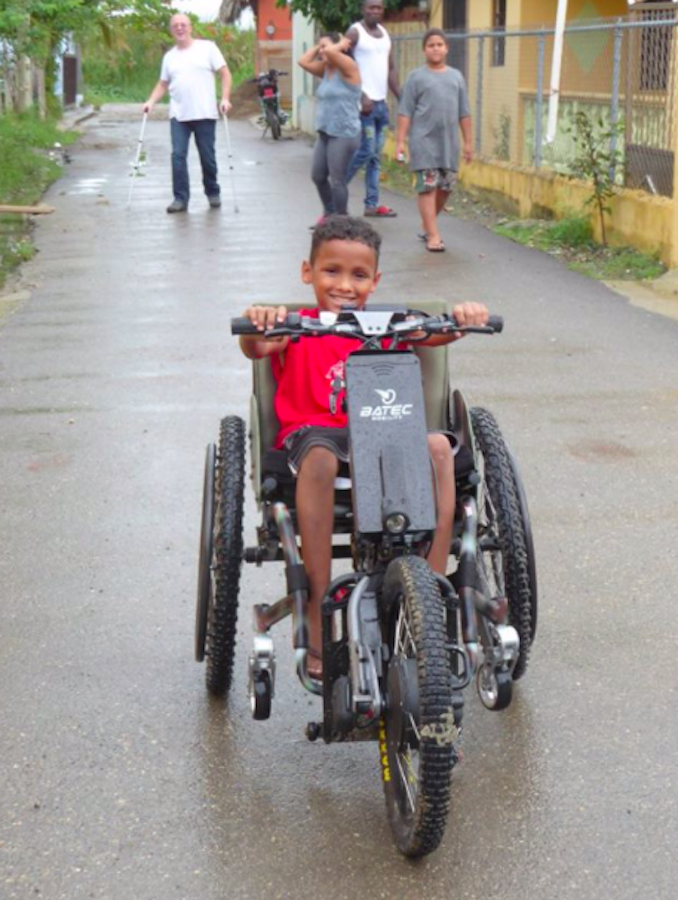
The Batec is made in Barcelona. In 1997, Pau Bach an eighteen year old guy on an Industrial Design course, acquired a disability following a road traffic accident. He didn’t like the products that were available to him as a wheelchair user, so he set about designing something himself. From there he grew Batec as a design & a company. Currently, more than half of the staff employed by Batec have a disability, ensuring that it is a social enterprise as well as an interesting and exciting product.
Again, everywhere I go, it attracts attention. When people first see it disconnected & then reconnected in a couple of seconds, not to mention the speed it will go at, they can’t help but be impressed. Buzzing around in my lightweight chair, powered by the Batec is great fun. With off-road tyres, it is also possible to take the chair and Batec to places that otherwise would be out of bounds, including on the beach. In the video clip, I was in the Dominican Republic. An international kite surfing competition was in err… full flight (sorry!) Despite all the healthy, bronzed, cool, beach guys & girls, it was the fifty year old disabled bloke in a wheelchair who was getting all the attention as I flew past the Red Bull tent…
…it must have given me wings!
[EDIT: When I’d uploaded the blog, I found the video was very slow to load. If you have trouble viewing it, you can see it on YouTube, although the ‘cheesy grin’ hasn’t been edited out on YouTube!]
In short, attracting attention to the wheelchair itself makes it so much more comfortable for people to acknowledge. Simply personalising the chair with spoke-guards will make a big difference. You have to be comfortable with the wheelchair in order to be confident.
Be proud and stand out even if you can’t stand up!
I’ll be blogging & reviewing the chairs properly in the future, but if anyone is thinking of buying one, feel free to drop me an email with any questions. I’m not on commission, so I can answer honestly! keith.fitton@outlook.com
https://batec-mobility.com/en/
